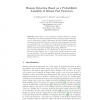Free Online Productivity Tools
i2Speak
i2Symbol
i2OCR
iTex2Img
iWeb2Print
iWeb2Shot
i2Type
iPdf2Split
iPdf2Merge
i2Bopomofo
i2Arabic
i2Style
i2Image
i2PDF
iLatex2Rtf
Sci2ools
ECCV
2004
Springer
2004
Springer
Human Detection Based on a Probabilistic Assembly of Robust Part Detectors
We describe a novel method for human detection in single images which can detect full bodies as well as close-up views in the presence of clutter and occlusion. Humans are modeled as flexible assemblies of parts, and robust part detection is the key to the approach. The parts are represented by co-occurrences of local features which captures the spatial layout of the part’s appearance. Feature selection and the part detectors are learnt from training images using AdaBoost. The detection algorithm is very efficient as (i) all part detectors use the same initial features, (ii) a coarse-to-fine cascade approach is used for part detection, (iii) a part assembly strategy reduces the number of spurious detections and the search space. The results outperform existing human detectors.
| Added | 01 Jul 2010 |
| Updated | 01 Jul 2010 |
| Type | Conference |
| Year | 2004 |
| Where | ECCV |
| Authors | Krystian Mikolajczyk, Cordelia Schmid, Andrew Zisserman |
Comments (0)

